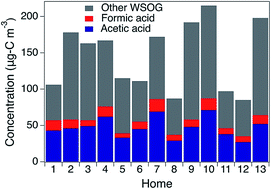Residential water-soluble organic gases: chemical characterization of a substantial contributor to indoor exposures†
Abstract
Characterization of residential indoor air is important to understanding exposures to airborne chemicals. While it is well known that non-polar VOCs are elevated indoors, polar VOCs remain poorly characterized. Recent measurements showed that total polar water-soluble organic gas (WSOG) concentrations are also much higher indoors than directly outdoors (on average 15× greater at 13 homes, on a carbon-mass basis). This work aims to chemically characterize these WSOG mixtures. Acetic, lactic, and formic acids account for 41% on average (30–54% across homes), of the total WSOG-carbon collected inside each home. Remaining WSOGs were characterized via high-resolution positive-mode electrospray ionization mass spectrometry. In total, 98 individual molecular formulas were detected. On average 67% contained the elements CHO, 11% CHN, 11% CHON, and 11% contained sulfur, phosphorus, or chlorine. Some molecular formulas are consistent with compounds having known indoor sources such as diethylene glycol (m/z+ 117.091, C4H10O3), hexamethylenetetramine (m/z+ 141.113, C6H12N4), and methacrylamide (m/z+ 86.060, C4H7NO). Exposure pathways, potential doses, and implications are discussed.

- This article is part of the themed collection: Indoor Air: Sources, Chemistry and Health Effects


 Please wait while we load your content...
Please wait while we load your content...